
Augustin Fresnel: lenses with concentric rings.
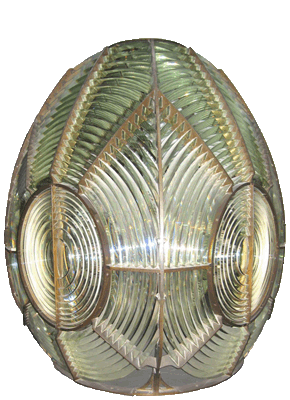

Until the 18th century, the coastline was poorly lit. There were 15 lighthouses built along the French coastline before 1775.
It was not until the creation of the Commission des Phares in 1811 and the lighting program of 1825 that things changed.
This program proposes to build 51 lighthouses, 40 harbour lights (read the "History of French Lighthouses" page) and increase the range of the optics.
Until now, the English lighthouses erected by Trinity House are equipped with copper reflectors. The principle is simple.
The light source (oil lamp) is placed in the focus of the parabolic reflector. This reflector has the property of making the refracted rays parallel.
This system can be installed on a rotating assembly.
Around 1770, these reflectors were installed in France. A system with 12 silver parabolic mirrors was installed at the Cordouan lighthouse in 1791.
Augustin Fresnel (born in Broglie on May 10, 1788) joined the Commission des Phares on June 21, 1819. He believes there is too much loss of light using the parabolic technique.
He thinks the loss of light is too important. He has heard about the studies of Georges-Louis Leclerc Buffon who used a magnifying glass to build lens.
It will focus the rays at a point called a focus.
He wants to enlarge his magnifying glass using a larger lens. But the lens becomes heavy and the thickness of the glass in the center increases the loss of light. He then invents the stepped lens.
The principle is simple. A large lens is made and the thickness of the glass that is not useful is removed. The weight is greatly reduced but the manufacturing is not simple. Buffon cannot proceed any further.
The image on the left shows how Buffon managed to lighten his optics. The image on the right shows, in blue, the useful part and in dotted line the removed part.
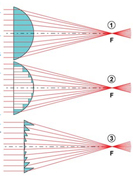
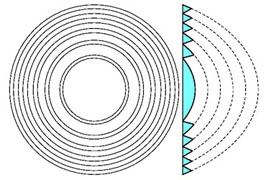
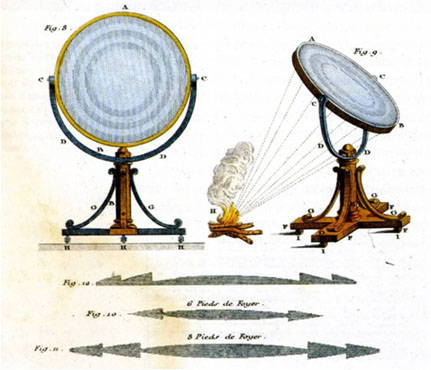
Fresnel takes up this study by Buffon, no longer concentrating the sunlight at the focus of the lens he wants diffuse the light of an oil lamp placed
at the focus.
It needs a large-scale optic but its manufacture is almost impossible. So he will have his optics made into several small pieces that he will then assemble.
Buffon had not thought about it.
Fresnel is therefore not the inventor of this new lens but has improved and adapted it for lighthouses.
Here is a picture of the Fresnel lens from 1820 and a picture from 1821.
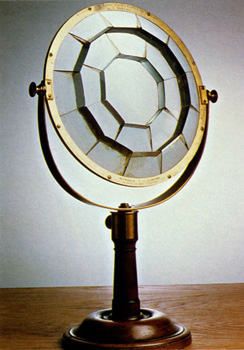
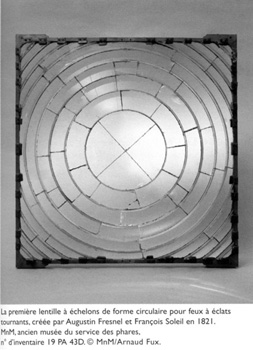
On August 29, 1819, he proposed replacing the metal reflectors with stepped lenses. His project was accepted.
After various tests, he presents a lighthouse lenses with 8 dioptric optics.
This project was accepted and installed at the Cordouan lighthouse in July 1823. This lighthouse was not chosen by chance.
He still wanted to prove that his optics were better than the English system which had been operating at Cordouan since 1791.
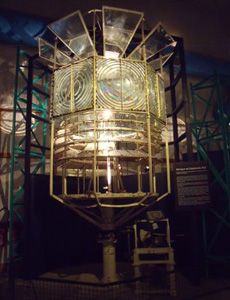
The set supplied to Cordouan consisted of optics, a new rotation system and an improved oil lamp.
The optics included 8 vertical Fresnel lenses with square sections. These were placed in the same plane as the light source and formed a regular octagon.
To recover the light passing by the lenses, he placed metal reflectors on top of them.
An opening is left above for the chimney and below the assembly for the lamp air supply.
Opposite is the optic delivered to Cordouan in 1823.
Later, these reflectors will be replaced by retro-reflective prisms.
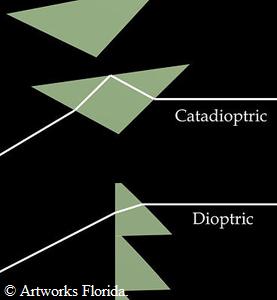
The animation below shows the path of the light rays.
His work was very successful and had shown that his lens has better performance. The glass is durable and its maintenance easier than the metal.
But it will ignore the cost of these optics.
His work did not stop there. Each lighthouse had different characteristics in terms of optics and it's rotation. This will make each lighthouse recognizable.
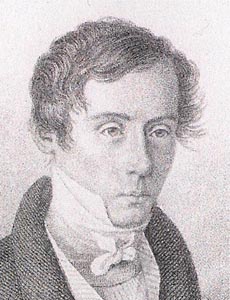
Augustin Fresnel.
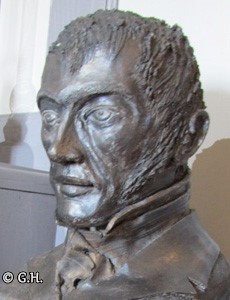
Léonor Fresnel.
Augustin Fresnel received the gold medal at the industrial exhibition in Paris in 1823 and was elected the same year to the Académie des Sciences.
His lens were a worldwide success, but he did not benefit from it. He died on July 14, 1827.
His brother Léonor replaced him at the Commission des Phares and continued his work.
He has contributed to safety at sea and the number of shipwrecks will be greatly reduced.
England waited 20 years before adopting the Fresnel lens.
In conclusion we can say that in 4 years Augustin Fresnel had revolutionized lighting with the first lenticular lens. Other developments will emerge later.
There will be the modernization of optical rotation systems (started by Fresnel for Cordouan).
The first two lighthouses were electrified in England in 1858 and 1862.
The first French lighthouse (la Hève) was electrified in 1863.
The result is an evolution in the type of lamp. We must not forget the arrival of wind turbines and solar panels.
The arrival of LEDs, their low consumption and their long lifespans, will still change things. Here is the latest information received for France:
"All buoys and lights up to 40 W are equipped with them. A new program is being deployed to equip the headlights and turrets up to 180 w, which should make the 3/4 of the headlights if not more. For headlights of higher power (Frehel type) they are equipped with metal halide lamps."
The first European headlight with LEDs is spanish .
Finally, mention should be made of automation.
Classifications.
The first classification is made according to the size of the optics. The measurement is taken on the focal plane, between the central lens and the focal
point.
The classification is made in 9 categories, from 1° order ( 920 mm) to 8° order ( 75 mm) without forgetting the hyper-radial and meso-radial optics.
These are the subject of another page.
The two drawings below show the 6 most common orders.
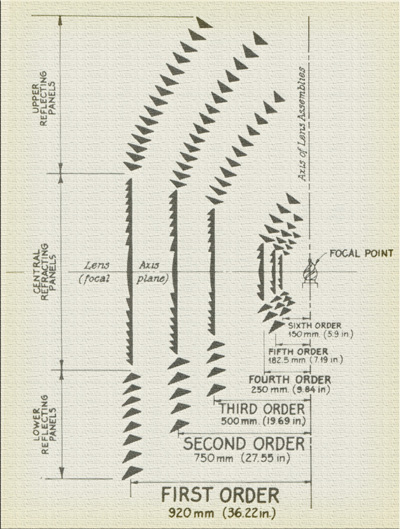
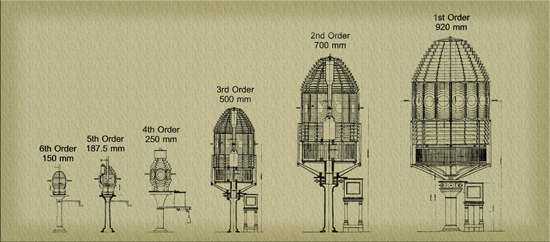
| Order. | Focal. | Height. | Weight. |
| First order | 920 mm 36,2 inches |
2590 mm 101,97 inches. |
5800 kg 12787 pounds |
| Second order | 700 mm 27,6 inches |
2070 mm 81,46 inches. |
1600 kg 3527 pounds |
| Third order | 500 mm 19,7 inches |
1576 mm 62,05 inches. |
900 kg 1984 pounds |
| Third and half order | 375 mm 14,7 inches |
1090 mm 42,9 inches. |
545 kg 1200 pounds |
| Fourth order | 250 mm 9,8 inches |
722 mm 28,43 inches. |
200 à 300 kg 441 à 661 pounds |
| Fifth order | 187,5 mm 7,4 inches |
541 mm 21,3 inches. |
120 à 200 kg 265 à 441 pounds |
| Sixth order | 150 mm 5,9 inches |
433 mm 17,05 inches. |
30 à 100 kg 65 à 220 pounds |
| Seventh order * | 140 mm 5.7 inches |
165 mm 6.5 inches. |
6.8 kg 15 pounds |
| Eighth order * | 75 mm 3.1 inches |
82 mm 3.25 inches. |
2.75 kg 6 pounds |
* The 7° and 8° order optics were manufactured for Canada and Scotland in limited copies.
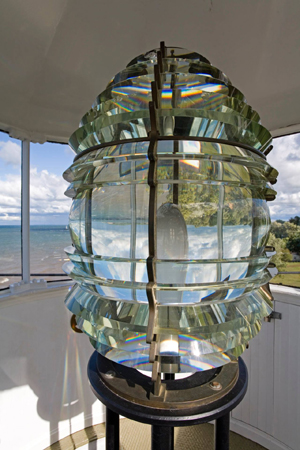
This optic is a 3-1/2 order of the
Sodus Point lighthouse, lac Ontario.
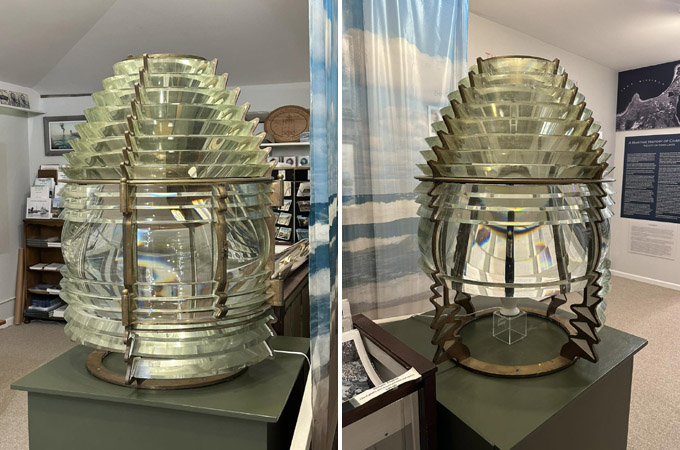
3-1/2 Order Fresnel lens at the Grays Reef Lighthouse in Lake Michigan.
Display at the Charlevoix Historical Society Museum in Charlevoix.
A second classification can be made according to whether the lenses are fixed or rotating.
The photo below shows the difference in lighting between the two types of optics.
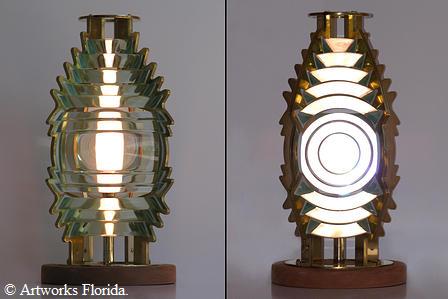
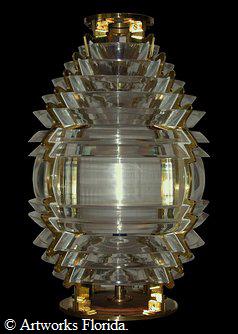
Fixed lens, 6° order.

Rotating lens, 6° order.
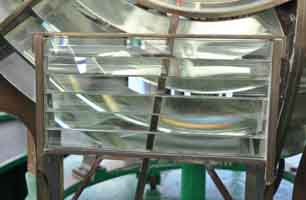
Finally, a special lens is placed on certain headlights. It is placed in the bottom and directs the light upwards.
The goal is to provide night lighting for air traffic. Below is a photo of this lens.
Some pictures and films.
Double lens of the lightouse "la Canche", filmed by Alain Roupie.
Optics of "la Garoupe" - vidéo by Joël Rosti.

One pannel of the "Créach".
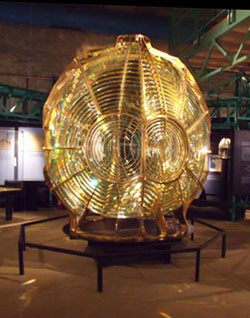
Optics of "La Désirade".
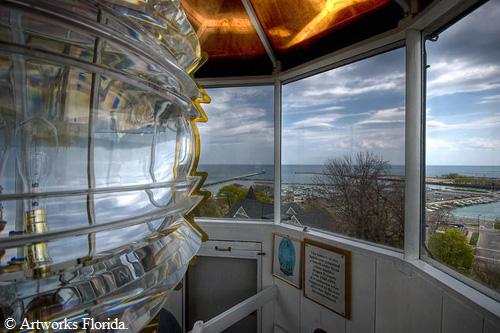


Different pages show differents optics in lighthouses.
Articles de référence.
Les premières lentilles de Fresnel – Patrice Lehuédé.
Les lentilles à échelons de Fresnel – Vincent Guigueno.
Artworks Florida , Floride.
Les livres renseignés dans la rubrique «Liens».
Origine des photos.
Le Musée des Phares et Balises situé sur l'île d'Ouessant et géré par le Parc Naturel Régional d'Armorique.Patrice Lehuédé.
Artworks Florida , Floride.
Je les en remercie.